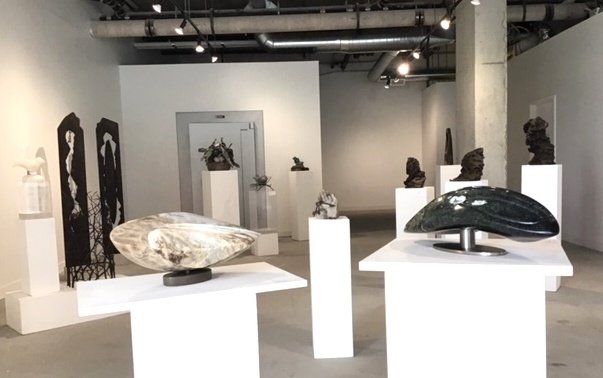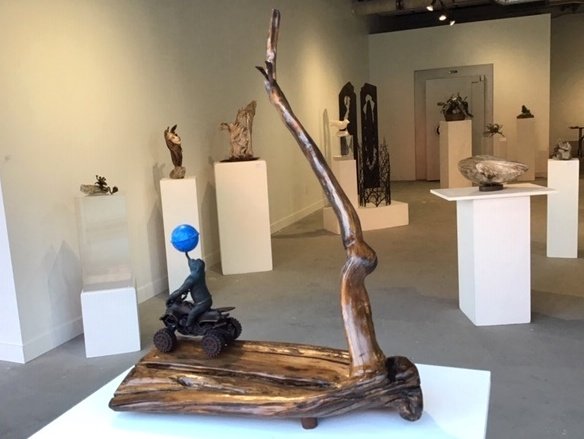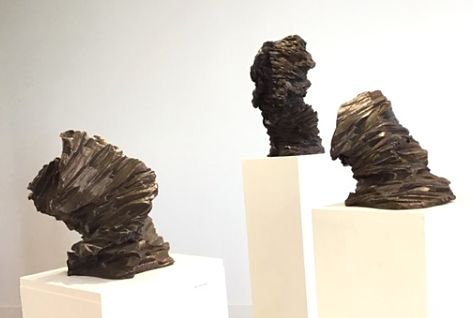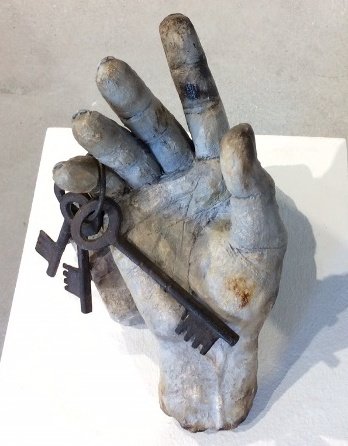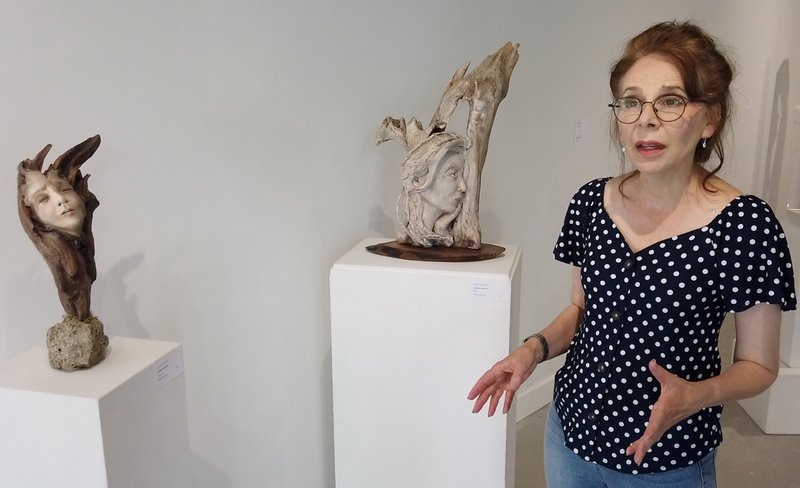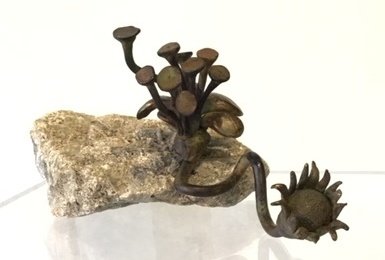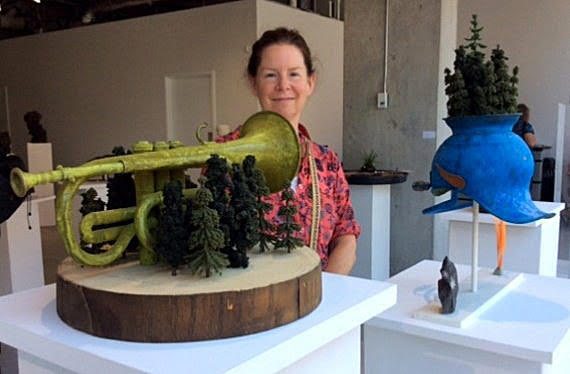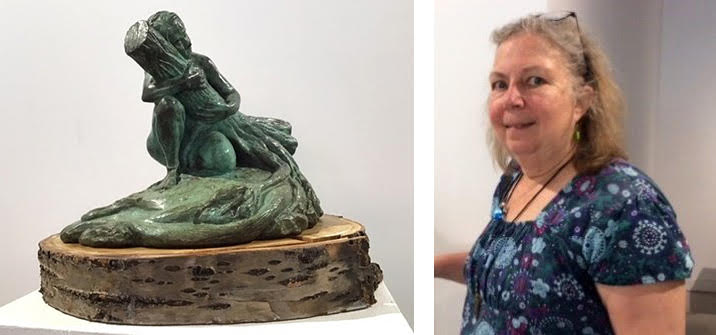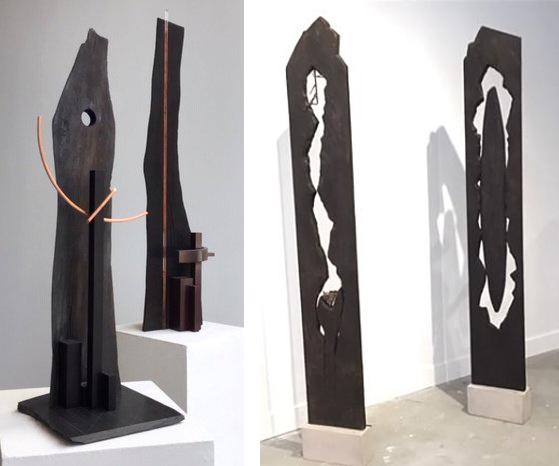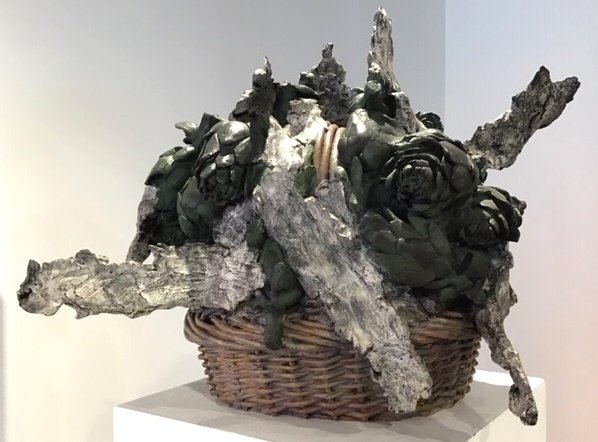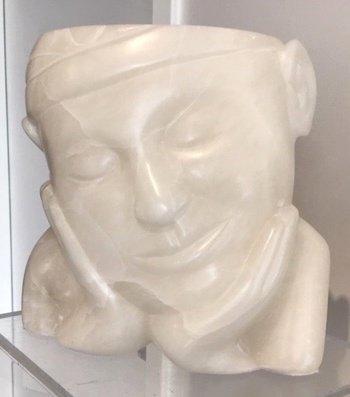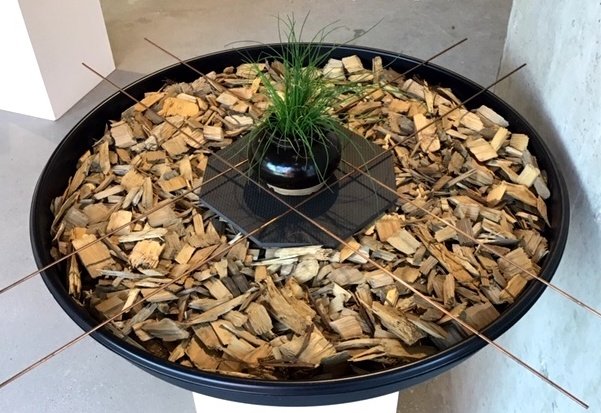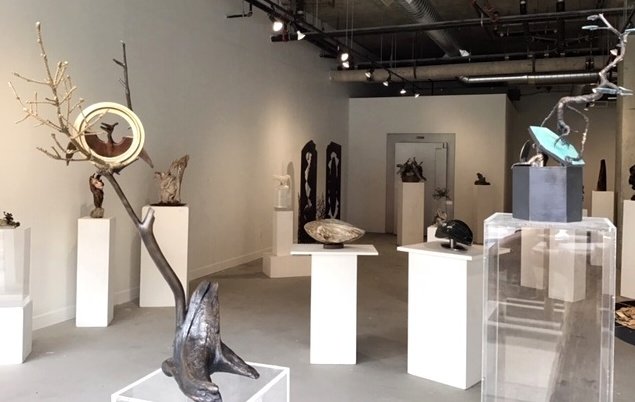Canadian Sculpture Centre reopened its door to the public on June 20th with EARTH WORKS, a group show by eleven Ontario and Quebec artists, dedicated to nature and environmental issues. They invite the visitor to examine our planet’s natural vulnerabilities and celebrate the vitality of life.
The best thing about group shows is that everyone can find something to love.
Angela Verlaeckt Clark’s abstract sculptures reference our shorelines with their blue colors and wave-like movements. Through the plight of a captured Orca she wants us to understand that “Our spirits, man and beast are united by the mystery of a breath…”
Installation view with Angela Verlaeckt Clark, Blue Shadowlines, blue anhydrite, quartz base, 25.5 x 53.5 x 23 cm (left) and Breathe, brucite, stainless steel base, 23 x 71 x 2 3 cm (right in front)
Cesar Forero, who is also a dancer, twists bronze into root-like shapes in The Underworld until it reminds us of a dancing figure. His other sculpture, Blowing the World, stands out with its humorous composition as the tractor seems headed to fall off the wooded world. As Forero said, his intent was “to create awareness on how intrinsic is the relation of plants, animals and humans, and how dependable we are on this network.”
Installation view with Cesar Forero, Blowing the World, bronze, wood, 48 x36 x 25 cm (in front)
Camie Geary-Martin’s abstract portraits invite the viewer to enjoy the uncertainties of the shapes, associating them with nervous or ecstatic feelings, and misplaced or vulnerable energies. It is a surprise to see these called Landscape but there’s a reason. Geary-Martin wrote that during her residency at the Vermont Studio Centre, she collected sticks, very selectively, while walking along the river, and the effect of water and wind on the landscape influenced her so strongly that she departed from her usual figurative style. She experimented with the sticks, beat the clay and created six of these pieces. It was later that she recognized that they were “figures of the landscape.”
Camie Geary-Martin, (L-R) Landscape #1, bronze, 28 x 30 x 28 cm, Landscape #2, bronze, 30 x 28 x 23cm, Landscape #3, bronze, 46 x 25 x 25 cm
When visiting the show Uzair Mehmood talked to three artists: Marlene Kawalez, Dina Torrans and Janine Lindgren about their exhibited works.
Kawalez said that through her 30 years experience as a sculptor she always loved the endless possibilities that clay provided. She talked very passionately about nature and what it means to her. Debating city vs nature, she found that in the city we are not really in touch with other people. On the other hand, nature accepts all kinds. While in the city we have no control over changes and it can be very chaotic and disturbing, nature is calm and complex. Talking about Link she said that those are the keys to nature held by a caring hand. It is not an easy task to keep and use them since they are heavy. It is also a reflection on the fact that we are getting further and further away from nature.
Marlene Kawalez, Link, clay, metal, stone, 20 x 15 x 20 cm
Kawalez’s two other pieces are less dramatic and more poetic. Once depicts a woman’s face with a melancholic expression emerging from (or disappearing into) a tree trunk. Maybe she is trying to escape it, reminding us for the old man, even a god, in the TV series Game of Thrones, who was trapped in a tree for life. Silence reveals the artist’s state of mind when she escapes into nature, closing her eyes so the positive spiritual energy can embrace her. Both figures’ facial expressions are beautiful, showing excellent craftsmanship. As Kawalez stated, “I have always found when the world ceases to make sense to me, I retreat back into Mother Nature. It is there that I find solace and comfort to rejuvenate my spirit.”
Marlene Kawalez with her sculptures Silent, clay, mixed-media, 46 x 18 x 15 cm (left) and Once, clay, mixed-media, 59 x 41 x 18 cm (right)
As far as Dina Torrans can remember she has always worked with her hands. Her father was an illustrator, her mother a musician, so it runs in the family. She was in high school when she knew for sure that she would become an artist. She always enjoyed working with materials like clay and bronze; mixing and assembling them. Seven years ago, she got interested in stone, cutting and carving it, and including it in her sculptures. Into the Wildwoods depicts a bunch of fungi-like mushrooms growing on a rock, much as we can find in every forest. Attached to it there is a conical shape of a flower. As Torrans explained, the contrast of the two motifs show how nature combines with whatever is thrown at her. She had fun working on this piece.
Dina Torrans: Into the Wildwoods, bronze, stone, 13 x 18 x 30 cm
In the series Torrans uses found objects from “nature-culture,” that may have existed in the past, parallel-exist now or will exist in the future. She incorporates a trumpet into a forest in Listen, further emphasizing her message with plastic letters forming ‘Listen’, coming out of the trumpet. She created this sculpture to protest clear cutting, to draw more attention to environmental problems by urging us to Listen to nature, and to re-establish the balance in it. Forest Warrior Artefact was originally a helmet and also a watering can. Here it becomes part of the uniform of a forest warrior who fights to preserve and maintain nature. The trees crowning the helmet are meant to give honor to the warrior. Torrans wrote about her themes that they “tend to be inspired by Nature, our human belief systems, personal & planetary evolution, and inter-connectedness.”
Dina Torrans with Listen, mixed-media, 22 x 45 x 35 cm (left) and Forest Warrior Artefact, mixed-media, 49 x 36 x 27 cm (right)
One of the most touching works in the exhibition is Tree Hugger by Janine Lindgren. The artist worked on this sculpture for a year, returning to it many times. She is interested in figure modelling and involving other elements to make a statement. In this case it is the environmental movement that started in the 1980s concerned about trees being cut down. Tree huggers are individuals who deeply respect and strive to protect and sustain forests. A girl hugs a fallen tree whose roots still struggle to reach the soil, trying to reconnect with earth. The figure is gently cradling the tree trunk with such intimacy that it shows how deeply she cares for it – drawing sympathy from the viewers. Lindgren clarifies that “By focusing on one human figure with a lone tree, I hope each individual viewer could relate in some way, invoking thought on the issue and the power of the individual to combat the climate crisis. I’m proud to be a “tree hugger” and by creating this work, which is a reflection of my values, pays homage to environmentalists, and I hope – speaks to viewers in a way that reaches their hearts, creating empathy for the cause.”
Janine Lindgren with Tree Hugger, bronze, 25 x 29 x 27 cm
Judy Rayner Ivkoff also addresses the natural physical environment as she explores energy, movement, time and regeneration. Each of her works are tall, linear and arboreal – and when viewed together they create a forest. Edward Falkenberg’s words accompanying his sculptures are very concerning and at the same time sardonic, “The quiet of the plaza and the world temperatures are rising at an alarming rate!!”
(L-R) Edward Falkenberg, The Plaza at Midnight, wood, copper, slate, 60 x 20 x 23 cm (left) and Temperature Rising, wood, plastic, 99 x 20 x 18 cm (right) & Judy Raymer Ivkoff, Forest #16 and #17, both wood, limestone, bronze, 210 x 30 x 13 cm
Laura Santini’s Artichoke Basket is a pleasant surprise, bringing back memories of painted and real fruit baskets – but without colors, adding the heaviness of metal. In a basket there are artichokes looking so real that it is almost scary. Santini mentioned that with picking everyday organic objects and transforming them into durable materials, a new language of expression seems to emerge.
Laura Santini, Artichoke Basket, bronze, 51 x 75 x 52 cm
Both Mary Ellen Farrow and Tsuii Yiin aim to find peace and balance. The soft beauty of the Italian alabaster head in Farrow’s sculpture (Serenity) brings the peace of a Buddha. Having the head resting on the hands makes it seems even more relaxed.
Mary Ellen Farrow, Serenity, Italian alabaster, 20 x 20 x 10 cm
Tsuii Yiin wrote that A Sense of Balance“…is my earth statement dedicated to my Mother who believed whole-heartedly in “earth’s karma” and the “Yin/Yang” philosophy.” The artist analyzes balance according to traditional Chinese beliefs and symbols where everything has its place and meaning. Copper, for example, is synonymous to wiring, representing life’s energy, while wood, a symbol of growth, supports the continuity of life. The balance created by all these elements still seems vulnerable, as the bowl can overturn and the fine metal rods might not be able to balance it. But it stands now like an altar for that little living grass in the middle.
Tsuii Yiin, A Sense of Balance, mixed-media, 27 x 90 x 90 cm
Earth Works is a wonderful exhibition to view with many interesting and thought-provoking works, worth of every minute of your time.
Installation view of EARTH WORKS
Kexin Wu, Uzair Mehmood and Emese Krunák-Hajagos
Images are courtesy of Canadian Sculpture Centre
*Exhibition information: June 20 – July 26, 2020, Canadian Sculpture Centre, 19 Mill Street, Distillery District. Gallery hours: Mon – Sat, 11 am – 5 pm; Sun, 12 – 5 pm.

